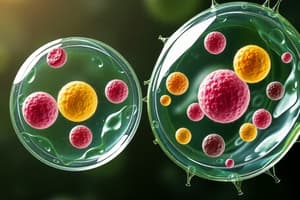Podcast
Questions and Answers
Ký tự nào xuất hiện nhiều nhất trong đoạn văn bản trên?
Ký tự nào xuất hiện nhiều nhất trong đoạn văn bản trên?
- c (correct)
- o
- '
- t
Dòng nào trong đoạn văn bản có số lượng ký tự ít nhất?
Dòng nào trong đoạn văn bản có số lượng ký tự ít nhất?
- \-C,On\ 0~ o9 CA
- L\. c \._. ~ o "'°' c.S
- t..A (correct)
- ~t,...,8 ~,C;;J n'1..,,g._~~ N.., ~
Ký tự nào xuất hiện duy nhất một lần trong dòng 'L. c ._. ~ o "'°' c.S'?
Ký tự nào xuất hiện duy nhất một lần trong dòng 'L. c ._. ~ o "'°' c.S'?
- .
- ' (correct)
- o
Số ký tự đặc biệt (không phải chữ cái hoặc số) trong đoạn văn bản là bao nhiêu?
Số ký tự đặc biệt (không phải chữ cái hoặc số) trong đoạn văn bản là bao nhiêu?
Dòng nào trong đoạn văn bản có số lượng chữ cái nhiều nhất?
Dòng nào trong đoạn văn bản có số lượng chữ cái nhiều nhất?
Flashcards
T..A
T..A
Một thuật ngữ có thể liên quan đến một chủ đề hoặc nội dung cụ thể.
L. c
L. c
Có thể liên quan đến một nghiên cứu hoặc một yếu tố cụ thể trong lý thuyết.
N..,
N..,
Một ký hiệu làm biểu thị cho việc thiếu thông tin hoặc một sự ngắt quãng trong dữ liệu.
C,On\ 0
C,On\ 0
Signup and view all the flashcards
CA
CA
Signup and view all the flashcards
Study Notes
Cell Theory
- Cells are the fundamental unit of life.
- All living things are made of cells.
- Cells come from other cells.
Prokaryotes vs. Eukaryotes
- Prokaryotes are simple, small cells without a nucleus or membrane-bound organelles.
- Eukaryotes are larger, more complex cells with a nucleus and membrane-bound organelles.
Basic Features of All Living Cells
- Membrane: a boundary around the cell, all cells need a membrane made of phospholipids.
- Cytosol/Cytoplasm: a jelly-like fluid within the cell.
- Ribosomes: make proteins.
- Chromatin & Chromosomes: carry genetic information.
Cell Organelles
- Plasma/Cell Membrane: surrounds the cell, regulates what enters and exits.
- Golgi Complex: modifies, sorts, and packages proteins.
- Lysosomes: contain enzymes to break down cellular waste.
- Endoplasmic Reticulum (ER): a series of membranes involved in synthesis and transport.
- Smooth ER: makes lipids and detoxifies poisons.
- Rough ER: makes proteins.
- Mitochondria: site of cellular respiration, produces energy.
- Cytoskeleton: gives the cell shape and structure.
- Microfilaments: smallest
- Intermediate Filaments: medium
- Microtubules: largest
- Vacuoles and vesicles: storage sacs
- Food vacuole
- Contractile vacuole - pumps water out of the cell
- Central vacuole (in plants): large storage space
- Chloroplasts (in plants and some protists): site of photosynthesis.
- Nucleus: controls cell activities, contains the DNA.
- Nuclear Envelope: surrounds and separates the nucleus from the cytoplasm.
- Ribosomes: protein synthesis.
- Chromosomes: structures containing DNA.
Kingdoms of Life
- Bacteria
- Archaea
- Protista
- Plantae
- Fungi
- Animalia
Microscopy
- Magnification: the ratio of the image size to the actual size of the specimen.
- Resolution: the ability to clearly distinguish between two separate points on a specimen.
- Microscope parts
- Objective lens: low power, high power, oil immersion
- Ocular lens: magnifying lens
- Contrast: making the specimen show up better
- Staining
- Scanning and lower power objective magnification
- Field of View: area visible through the microscope.
- Inversion Phenomenon: the image appears upside down and reversed.
Observing Plant cells
- Examining plant cells (e.g., potato, onion) using a microscope.
- Visualizing cellular structures and observing differences in cell size, shape, and color.
Studying That Suits You
Use AI to generate personalized quizzes and flashcards to suit your learning preferences.




